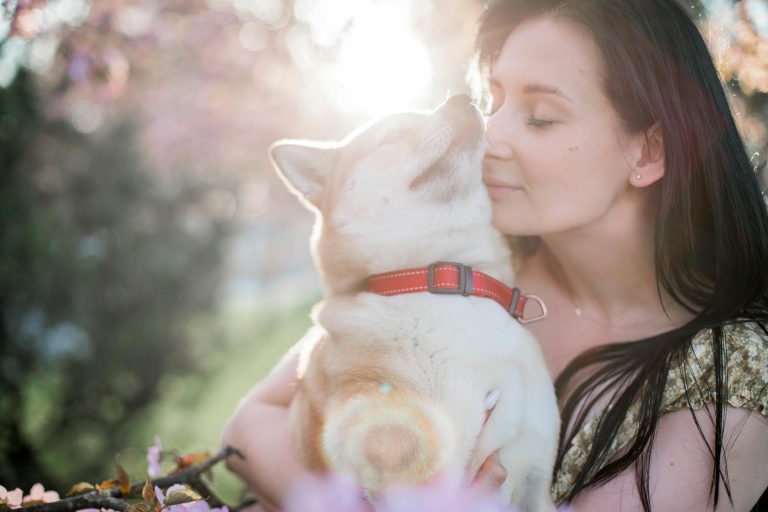Why Do Dogs Show You Their Belly? Understanding Canine Communication
Have you ever wondered why your furry friend rolls over, exposing their belly to you? It’s not just a cute gesture; it’s a form of communication deeply rooted in their evolutionary history. In this article, we’ll explore the intriguing behavior of dogs showing their bellies and decipher the messages behind this action.

Dogs Show You Their Belly: Decoding Canine Language
What Does it Mean?
When a dog shows you their belly, it’s a vulnerable position. Contrary to popular belief, it’s not always an invitation for a belly rub. Dogs have various reasons for displaying this behavior, and understanding them can strengthen your bond with your four-legged companion.
Instinctual Behavior in Dogs
This action has roots in the instincts inherited from their wild ancestors. In the wild, exposing the belly could signal submission to the pack leader or indicate trust among pack members. While domestication has altered some behaviors, this instinct to reveal vulnerability remains.
Trust and Vulnerability
When a dog shows you their belly, it’s a clear sign of trust. In the canine world, vulnerability is a powerful tool for building relationships. By allowing access to their most sensitive area, dogs demonstrate a level of comfort and confidence in their surroundings.
Historical Perspective: Evolution and Domestication
Evolutionary Roots
To truly understand this behavior, we need to look back to the wild ancestors of our beloved pets. In the wild, wolves and other canids displayed their bellies to show submission and build social bonds within the pack.
Domestication Impact on Behavior
As dogs evolved alongside humans, their behavior adapted to fit the dynamics of domestic life. While the instinct to expose the belly remains, its meaning has expanded to include trust and affection toward their human companions.
Communication Signals: Beyond Words
Non-Verbal Communication in Dogs
Dogs communicate primarily through body language, and the belly display is a powerful non-verbal signal. Understanding these cues allows you to connect with your dog on a deeper level.
Different Belly Exposures and Meanings
Not all belly displays carry the same message. A fully exposed belly might signify trust and submission, while a slightly exposed belly with paws tucked could indicate playfulness. Learning to differentiate these signals enhances your ability to respond appropriately.
Social Hierarchy and Submission
Pack Dynamics
In the wild, wolves establish a social hierarchy within the pack. Submissive gestures, like exposing the belly, help maintain order and harmony. In a domestic setting, dogs may exhibit this behavior to convey their role within the family.
Submissive Gesture Explained
When your dog shows you their belly, it’s a submissive gesture. They acknowledge your leadership and trust your judgment. Responding positively to this vulnerability reinforces the bond between you and your furry friend.
Comfort and Relaxation: Creating Safe Spaces
Safe Environments
Dogs are more likely to display their bellies in environments they perceive as safe. Creating a comfortable and secure space at home encourages this behavior, allowing your dog to relax and express their trust.
Relationship Building
Encouraging belly displays fosters a positive relationship. Regular displays indicate your dog feels secure and valued, leading to a stronger connection between you and your pet.

Playful Behavior: Unveiling the Joy
Playfulness Indicators
Not all belly displays are submissive; some are an invitation to play. Pay attention to additional cues like a wagging tail and an excited demeanor. Engaging in play reinforces the joyous aspect of your relationship.
Encouraging Healthy Play
To encourage healthy play, reciprocate the enthusiasm. Engage in gentle belly rubs or initiate playful activities. This strengthens the bond and creates a positive association with belly displays.
Addressing Misconceptions: Dispelling Myths
Common Myths
Misconceptions about belly displays abound. One common myth is that all dogs love belly rubs. In reality, some dogs may not enjoy this interaction, and it’s crucial to respect individual preferences.
Understanding Context
Context matters when interpreting canine behavior. Consider the overall body language, the situation, and your dog’s personality. Each display is unique, and understanding the context ensures appropriate responses.
Interpreting Other Body Language: Beyond the Belly
Tail Wagging
While the belly display is significant, it’s essential to consider other body language cues. Tail wagging, for example, can convey excitement, friendliness, or even nervousness. A holistic approach to interpretation enhances communication.
Ears and Eyes Signals
Pay attention to your dog’s ears and eyes, which also communicate their emotional state. Erect ears may signal alertness, while relaxed eyes indicate comfort. Combining these cues provides a more comprehensive understanding of your dog’s feelings.
Training and Positive Reinforcement: Nurturing Behavior
Reinforcing Positive Behavior
Positive reinforcement is a powerful tool in training. When your dog displays their belly, reinforce the behavior with praise or a gentle rub. This creates a positive association and encourages repetition.
Building Trust through Training
Consistent positive reinforcement builds trust. Training sessions that incorporate rewards for desired behavior enhance your dog’s confidence and strengthen the bond between you and your pet.
Health-Related Considerations: Listening to Your Pet
Physical Discomfort
Occasional reluctance to display the belly might indicate physical discomfort. Pay attention to changes in behavior and consult with a vet if you notice any signs of pain or discomfort.
Signs of Discomfort
Understanding signs of discomfort, such as avoiding belly displays or flinching during touch, is crucial. Regular vet check-ups and open communication with your pet ensure their overall well-being.
Personalized Approaches: Tailoring Interactions
Knowing Your Dog
Every dog is unique. Understanding your pet’s personality, preferences, and history enhances your ability to interpret their behavior accurately. Tailor your interactions to suit your dog’s comfort level and preferences.
Tailoring Interactions
Adapting your approach based on individual preferences fosters a trusting relationship. Some dogs may prefer belly rubs, while others may appreciate a gentle scratch. Knowing your dog allows you to provide the right kind of interaction.
When Not to Approach: Respecting Boundaries
Recognizing Warning Signs
While belly displays are generally positive, it’s crucial to recognize warning signs. If your dog seems uncomfortable or displays defensive behavior, respect their boundaries and avoid approaching.
Respecting Boundaries
Respecting your dog’s boundaries is essential for maintaining a healthy relationship. If your pet prefers not to have their belly touched, find other ways to express affection and build trust.
Conclusion
In conclusion, a dog showing you their belly is a complex form of communication, encompassing trust, submission, and playfulness. By understanding the context and combining it with other body language cues, you can build a stronger bond with your furry companion. Pay attention to your dog’s unique preferences, and always respect their boundaries for a harmonious relationship.




Leave a comment